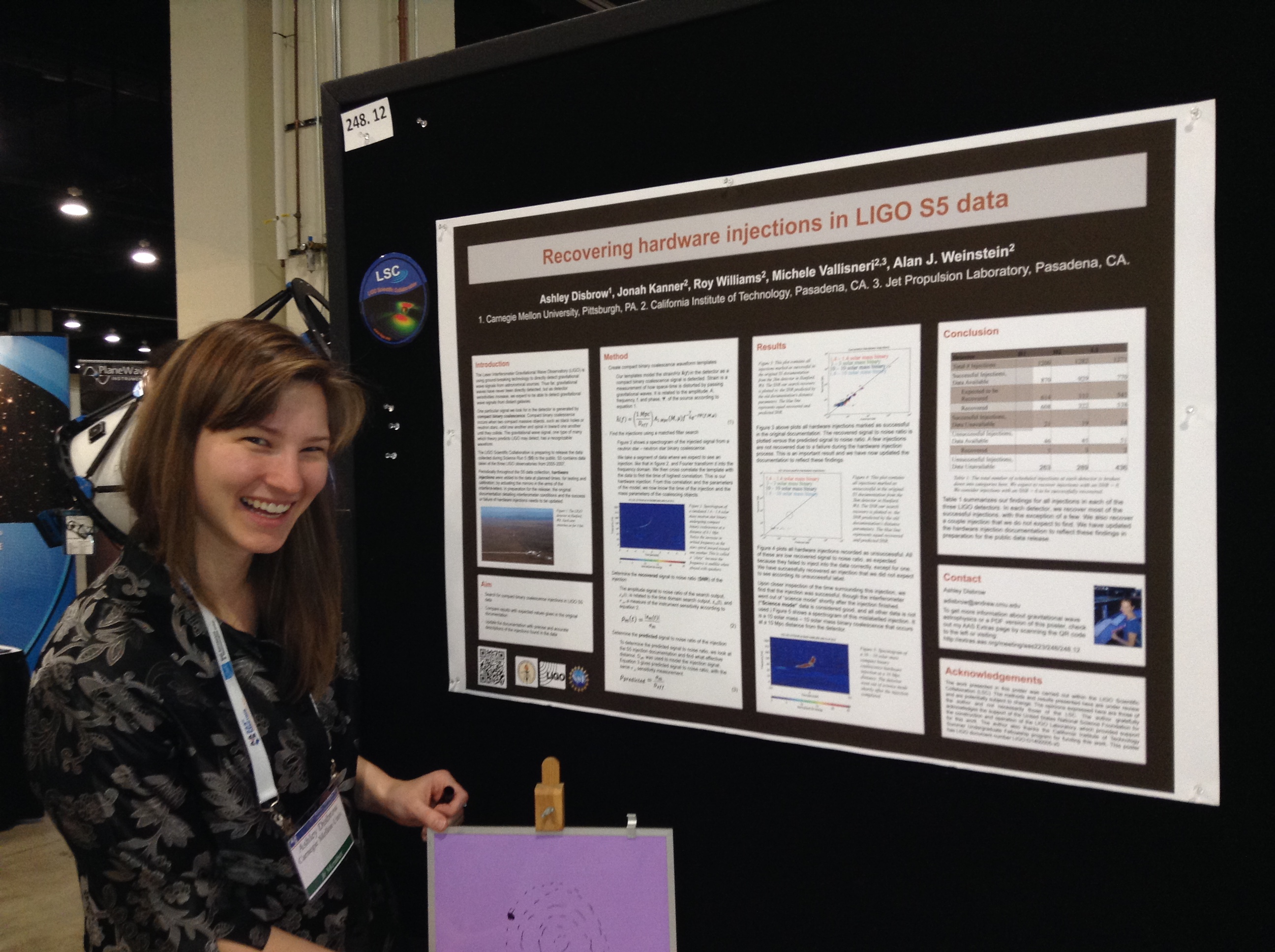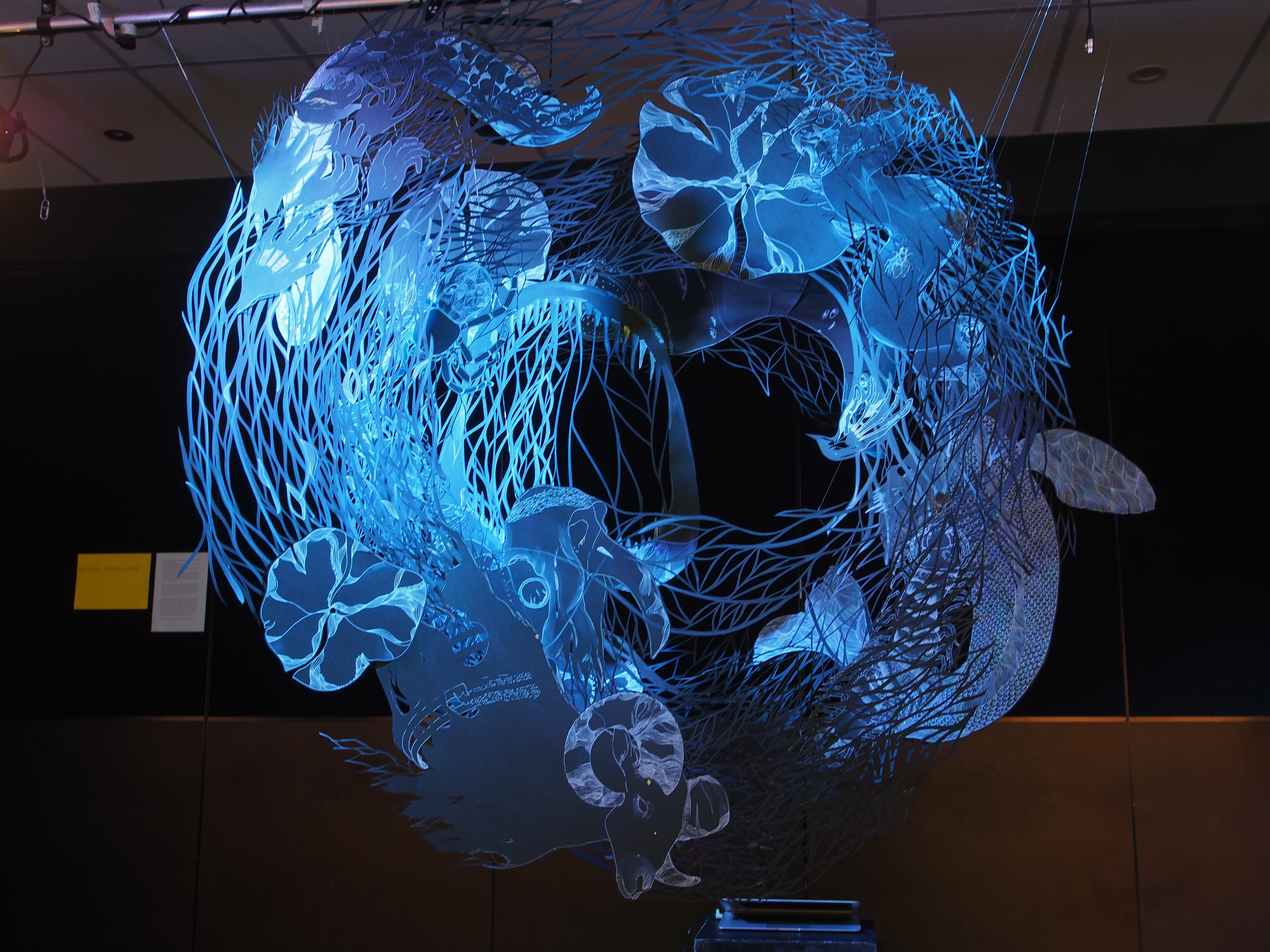Projects with GWOSC data
Some examples of projects using GWOSC data are shown on this page.
Listing a project here does not imply endorsement by LIGO Laboratory, the LIGO Scientific Collaboration or the Virgo Collaboration.
If you have completed a project with GWOSC data, please let us know!

Student Ashley Disbrow presents her work at the 2014 American Astronomical Society meeting in Washington, DC.

Student Emma Wadley created the installation art, titled Void (2016), shown above. Her artist statement includes this description: "I have used black paper to represent fear through the colour associated with death, shadows and the deepest nights ... The addition of light creates an eerie iridescence and the soundscape aims to unnerve and intrigue through otherworldly noise of Gravitational waves and the Mariana Trench."
Scientific Publications
Below are the most recent publications citing GWOSC, based on a query to INSPIRE.
1) Identification of Noise-Associated Glitches in KAGRA O3GK with Hveto
T. Akutsu, M. Ando, M. Aoumi, et al.
2) Adding equatorial-asymmetric effects for spin-precessing binaries into the SEOBNRv5PHM waveform model
Héctor Estellés, Alessandra Buonanno, Raffi Enficiaud, et al.
3) Validating Sequential Monte Carlo for Gravitational-Wave Inference
Michael J. Williams, Minas Karamanis, Yilin Luo, et al.
4) Primordial Gravitational Waves as Complementary Probe of Dark Matter Indirect Detection
Anish Ghoshal, Debarun Paul, Supratik Pal
5) Direct Inference of Nuclear Equation-of-State Parameters from Gravitational-Wave Observations
Brendan T. Reed, Cassandra L. Armstrong, Rahul Somasundaram, et al.
6) Black Hole - Neutron Star and Binary Neutron Star Mergers from Population III and II stars
Benedetta Mestichelli, Michela Mapelli, Filippo Santoliquido, et al.
7) Gravitational wave propagation in hybrid metric-Palatini gravity
Cláudio Gomes, João Luís Rosa, Miguel A.S. Pinto
8) Effectiveness of stacks in the stacked Hilbert-Huang transform
Lupin Chun-Che Lin, Chin-Ping Hu, Chien-Chang Yen, et al.
9) Gravitational Waves from Spectator Scalar Fields
Marcos A.G. Garcia, Sarunas Verner
10) AthenaK simulations of the binary black hole merger GW150914
David Radice, Rossella Gamba, Hengrui Zhu, et al.
11) A Glitch and the Matrix: Advances in Gravitational-Wave Glitch Mitigation and Acceleration of Pulsar Timing Analyses
Sophie Rose Hourihane
12) Probing Astrophysics, Cosmology, and Nuclear Physics with Gravitational Waves from Black Holes and Neutron Stars
Jacob Matthew Golomb
13) First eccentric inspiral-merger-ringdown analysis of neutron star-black hole mergers
Maria de Lluc Planas, Sascha Husa, Antoni Ramos-Buades, et al.
14) Excess of substructure due to primordial black holes
Patricio Colazo, Nelson Padilla, Federico Stasyszyn
15) A machine learning-enabled search for binary black hole mergers in LIGO-Virgo-KAGRAs third observing run
Ethan Marx, William Benoit, Trevor Blodgett, et al.
16) A Falsifiable Alternative to General Relativity
Daniel Coumbe, Aria Rahmaty
17) A Hubble constant estimation with dark standard sirens and galaxy cluster catalogues
Freija Beirnaert, Gergely Dálya, Archisman Ghosh
18) Measuring spin precession from massive black hole binaries with gravitational waves: insights from time-domain signal morphology
Simona J. Miller, Maximiliano Isi, Katerina Chatziioannou, et al.
19) Searching for Precessing Black Hole Binaries in Gravitational-wave Data
Stefano Schmidt
20) Scalar-Induced Gravitational Waves in Palatini $f(R)$ Gravity
Samuel Sánchez López, José Jaime Terente Díaz
Other Projects
Student projects at SUNY New Paltz (Starting in 2021)
Student projects mentored by Eric Myers
Final papers: Spy Hill Research
Pioneer Academics student projects (2015-2021)
Student projects mentored by Eric Myers
Final Papers: Spy Hill Research
Effect of Low Frequency Noise in Detection of Gravitational Waves
Baisakhi Mitra
Gravitational Wave Events (iPhone App)
Peter Kramer
Evidence for Small-Strain Burst Sources Proliferating in Enhanced-LIGO Time Series Data
Stanley W. Wong and Baokun Gu Report on Google Docs
Calculating detection ranges for binary black holes
Bassel Heiba Code on github
GW150914 Kaggle Projects
Created by Elena Cuoco GW150914 data in Kaggle
Online Course - LIGO: Detecting Gravitational Waves
Created at Sonoma State University by Lynn Cominsky SSU LIGO Courses | 2016 Course
Art Installation: Void
Emma Wadley See photo above
Modified LIGO data analysis notebook
Valentin Baillard Azure | mybinder | github
Physics From Planet Earth homework problems
Joe Amato and Enrique (Kiko) Galvez See Gravitational Radiation 2 and Gravitational Radiation 3
Non-Gaussian noise and data analysis of laser interferometric gravitational wave detectors
Takahiro Yamamoto, Ph.D. Thesis See JGW-P1605355
Gravitational Wave Detection in the Introductory Lab
Lior M. BurkoGeorgia Gwinnett College, See arxiv:1602.04666
Pioneer Academics student projects
Projects mentored by Eric Myers Final papers: Jinghong Liang | William Li
Searching for Compact Binaries in LIGO Data
Shannon Wang Date Completed: September 2014 Report: Paper
Recovering S5 Burst Injections
Alexander Cole Date Completed: May 2014 Presentation: Paper | Slides
S5 Data Time Dependence of Duty Cycles and Spacetime Detection Volumes
Gary LaMotte Date Completed: April 2014 Presentation: Slides
Recovering Hardware Injections in LIGO S5 Data
Ashley Disbrow Date Completed: September 2013 Presentations: Poster | Slides
Share your own GWOSC data project
For help getting started on a GWOSC data project, or if you have completed work that you would like to share, please contact the GWOSC team.
Please remember to cite or acknowledge GWOSC if using any products from this web site.
